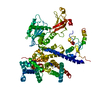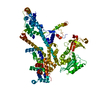+Search query
-Structure paper
| Title | Cooperation between intrinsically disordered and ordered regions of Spt6 regulates nucleosome and Pol II CTD binding, and nucleosome assembly. |
|---|---|
| Journal, issue, pages | Nucleic Acids Res, Vol. 50, Issue 10, Page 5961-5973, Year 2022 |
| Publish date | Jun 10, 2022 |
 Authors Authors | Aiste Kasiliauskaite / Karel Kubicek / Tomas Klumpler / Martina Zanova / David Zapletal / Eliska Koutna / Jiri Novacek / Richard Stefl /  |
| PubMed Abstract | Transcription elongation factor Spt6 associates with RNA polymerase II (Pol II) and acts as a histone chaperone, which promotes the reassembly of nucleosomes following the passage of Pol II. The ...Transcription elongation factor Spt6 associates with RNA polymerase II (Pol II) and acts as a histone chaperone, which promotes the reassembly of nucleosomes following the passage of Pol II. The precise mechanism of nucleosome reassembly mediated by Spt6 remains unclear. In this study, we used a hybrid approach combining cryo-electron microscopy and small-angle X-ray scattering to visualize the architecture of Spt6 from Saccharomyces cerevisiae. The reconstructed overall architecture of Spt6 reveals not only the core of Spt6, but also its flexible N- and C-termini, which are critical for Spt6's function. We found that the acidic N-terminal region of Spt6 prevents the binding of Spt6 not only to the Pol II CTD and Pol II CTD-linker, but also to pre-formed intact nucleosomes and nucleosomal DNA. The N-terminal region of Spt6 self-associates with the tSH2 domain and the core of Spt6 and thus controls binding to Pol II and nucleosomes. Furthermore, we found that Spt6 promotes the assembly of nucleosomes in vitro. These data indicate that the cooperation between the intrinsically disordered and structured regions of Spt6 regulates nucleosome and Pol II CTD binding, and also nucleosome assembly. |
 External links External links |  Nucleic Acids Res / Nucleic Acids Res /  PubMed:35640611 / PubMed:35640611 /  PubMed Central PubMed Central |
| Methods | EM (single particle) |
| Resolution | 3.71 - 3.88 Å |
| Structure data | EMDB-12704, PDB-7o3d: EMDB-12737, PDB-7o6b: |
| Source |
|
 Keywords Keywords |  CHAPERONE / Spt6 / CHAPERONE / Spt6 /  elongation factor / RNA Pol II / elongation factor / RNA Pol II /  nucleosome / CTD nucleosome / CTD |
 Movie
Movie Controller
Controller Structure viewers
Structure viewers About Yorodumi Papers
About Yorodumi Papers








